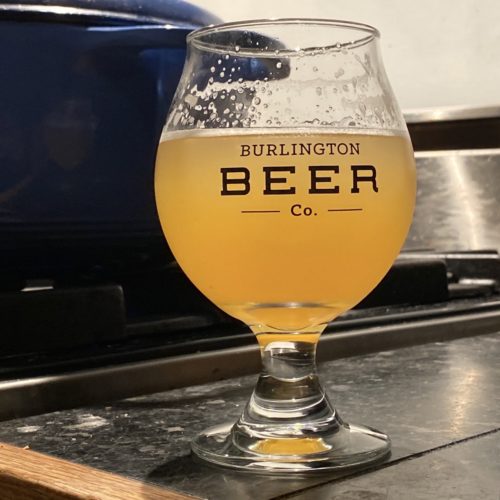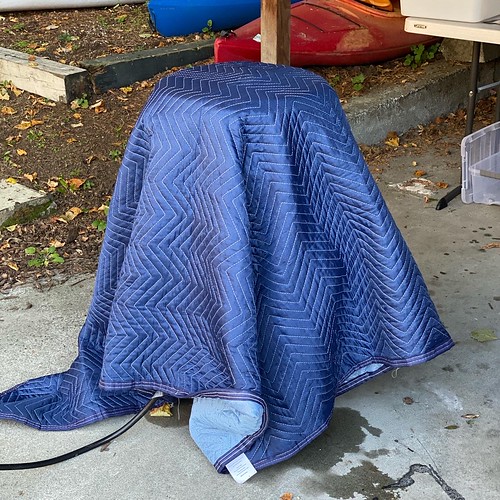Homebrew #92: Clone in the Window (Mk. II)
¶ by Rob FrieselI already mentioned some Vermont homesickness. Well… it’s not going to be cured by just a single batch. It’s going to take multiples. It seemed fair to clone the mead first because the mead scene here is… not Vermont’s. That said, I’ve been able to get some decent beers. Even some decent rye IPAs. But Light in the Window will forever 1 be my go-to. And since BBCO stopped production and we moved 3,000 miles away… there was only one solution to this. Re-group on Clone in the Window:

First… where did we leave off on this one? When we last saw Clone in the Window, the majority of the 5 gallon keg went fast at a certain house party that we threw. In other words, I’d gotten to have some of it, but not nearly as much as I’d hoped. (On the other hand, I had happy guests.) My own notes said: (emphasis added)
When I make this again, I think I’ll be focusing mostly on process changes. First, I suspect that the mash fell too much too quickly what with the garage temperatures being what they were. A steadier mash holding in the right range will help it achieve the right level of fermentability. (Barring that… dare I say a step mash might be in order?) Second, the dry hopping rate needs to be higher; and although there’s some romance to using whole cone, I’ll probably switch to pellets. I’d also consider switching from 1056 to 1318 and possibly doing part of the dry hop schedule during high krausen.
Which is a pretty good summary of my changes.
Except for when I got to the local HBS and had to change up some ingredients based on availability. Which mostly just means maltsters. (Alas! bye-bye Weyermann rye…)
And then there was the yeast switch — i.e., from Wyeast 1056 to Imperial’s Flagship. But that was calculated.
Brew Day
Regular readers will recall that I had a few… challenges the first time I brewed in our new Seattle home. I did my best to overcome those:
- Bought a long-stemmed lighter.
- Bought a second hose to daisy-chain them for my water supply.
- Lowered my burner.
- And came up with a better (though still not great) strategy for dealing with chiller waste water.
All that in place — time to brew!

Which of course begins with a frustrating milling experience. Tl;dr: it was getting all jammed up — which is something it has had a tendency to do, but this was really bad! After several (i.e., 5+) false starts, I finally opened up the mill gap slightly and… MAGIC. (“OK nobody touch anything!”)
Got my water collected, portioned out my infusions, got the flame going, and was mashed in by 11:05am.

Forty minutes at roughly 149 ºF. Then an almost-boiling water infusion for 30 minutes at 158 ºF. Then a boiling water infusion to mash-out. (That said — I forgot to take pH readings!)
And then a couple of small-ish tragedies.
- Despite lowering the burner, it still wasn’t quite enough for the hoisted bag to clear the rim of the kettle. This was better (maybe even tolerable) compared to the last time — but my calculations were off by maybe about 1-2 inches.
- That said, the consequence of having the hoisted bag bumping up (and resting) against the edge of the kettle? Some of the wort is “leaking” over the rim — getting the kettle wall sticky and otherwise running out onto the ground.
- So I tried to lower it… slowly and gently. Only it slipped! And the bag splashed back into the wort. Splashing wort onto me and out onto the ground. It wasn’t all that much wort (maybe a quart or two?) — but it was enough to be frustrating. And embarrassing.
- Hoist again — this time trying to keep the bag centered and gently squeezing, etc. And what in the actual hell but damn did my back tweak something fiercely. I wasn’t even really doing anything — the bag was on the hoist etc. and I just leaned forward slightly to check the thermometer and POP! Yikes.
But we’re too far along to bail out now. Must power through.

OK — 6.75 gallons of wort at roughly 1.049 2 gets a 60 minute boil. Then chilled as much as 15 minutes will chill it (down to about 72 ºF). Then hustle the fermentor down into the chest freezer.
Fortunately everything after my back popping was pretty uneventful. 3
Collected approximately 5.5 gallons with O.G. 1.060.
Fermentation
When the wort got down to pitching temperatures (<64 ºF), I directly pitched the pack of Imperial’s A07 Flagship and set the controller to 64±1 ºF.
The next morning it was definitely fermenting, so I set the controller to 68±1 ºF and unplugged the heater wrap to let it free-rise.
At +48 hours from pitching, I added 2 oz. of Chinook, contained in a stainless steel mesh container.
At +86 hours, with fermentation apparently slowing down, I brought the temperature up to 70±1 ºF. (Yes, I plugged the heater wrap back in.)
At +184 hours, I dropped the controller to 66±1 ºF. Then (later in the day) it occurs to me that the basement is holding in the low-60s ºF anyway and so keeping it in the chest freezer is a waste of energy unless I want to do a full on cold crash. Which I don’t. I moved it out of there and up onto a tall table and took a sample for a hydrometer reading. (1.012.)
At +192 hours, I added another 4 oz. of Chinook for the second round of dry hopping. A little gelatin went in at approx. +291 hours. Then we left for a long weekend.
Packaging
Packaging doesn’t normally get its own heading in these blog posts but… this was a weird one.
I sanitized my “Brew Bucket-to-Keg kit” as usual, and drew off a sample for the final gravity reading (1.010!) and then hooked up everything. I opened the valve on the Brew Bucket and… nothing happened. Which… wait…
WTF?
I just drew a sample through that valve. And all the hop matter is supposedly contained in those stainless steel mesh tubes. So… what’s going on? My first thought was: Maybe the compacted yeast cake is just REALLY THICK and covering the racking arm? But if that were true, then how was I able to draw off that initial sample? It’ll remain a mystery though because after a few minutes of this I opted for drastic measures.
I sanitized my trust siphon and just… siphoned the beer into the keg. Done and done. And maybe more Oâ‚‚ than if I’d done it my usual way but let’s face it, none of my transfers are truly Oâ‚‚-free.
Either way… force carbonate and let’s get to drinking it, shall we? 4
Overall Impressions
It’s delicious. It’s not exactly the BBCO beer from my memory, but I guess since it’s out of production anyway, it gets to be my beer now?

AROMA. Hop-forward; medium intensity citrus (orange flesh and zest), moderate pine, moderate stone fruit (apricot). Moderate intensity grainy-sweet malt. Low fruity ester. No detectable DMS, diacetyl, nor acetaldehyde.
APPEARANCE. Pale gold. Significant haze but not New England hazy. Tall stand of tight white foam with excellent persistence. Plenty of fine, fast-rising bubbles.
FLAVOR. Largely follows aroma. Hops lead; medium citrus (orange flesh and zest), medium-low stone fruit (apricot), low pine (but more pronounced retronasally). Malt is grainy-sweet and moderately-low but sufficient and supportive; earthy-spicy background notes suggest the presence of the rye. Light fruity ester evokes an underripe compound berry. Medium bitterness but firm, and lingering well into the finish. Dry.
MOUTHFEEL. Medium-light body. Medium carbonation. No significant astringency. No significant creaminess. Alcohol is detectable but not especially warming. Smooth overall, with a snappy finish.
OVERALL IMPRESSION. I think it’s a very good (dare I say excellent?) example of the style, but this misses the mark ever-so-slightly as far the source material is concerned. (Maybe Joe was right about the Weyermann rye malt?) Reads like a rye IPA alright — a little rye kick to an otherwise clean grainy-sweet malt backbone, and pile on top of that the characteristic citrus and pine notes of Chinook. That said, the hop intensity is a little less than I’d wished for (and remember?) — but I still love it!
Changes (or not) for next time?
- Keep the step mash.
- Grist proportions are roughly right the way they are.
- Flagship worked fine for yeast, but I wonder what this would be like with a more expressive strain?
- The Chinook works well here (and I’m such a fan of it anyway) — but I’m still chasing better ways to get the intensity level up. Experiment with keg hopping again?
Anyway, like I said last time: it’s nice to have Light in the Window again, even if it’s only at my house.
Recipe
The all-grain (BIAB) recipe for Clone in the Window is as follows: Like last time, I don’t feel like this is my recipe to give away. Perhaps I’ll ask if I can publish it here, and if I get the green light then I’ll update the post with those details. In the absence of such permission… “The secret is that Weyermann rye.” 5
Details
Clone in the Window (Mk. II), a rye IPA clone by Tilde Gravitywerks
| Original Gravity | 1.060 |
| Final Gravity | 1.010 |
| ABV | 6.6% |
| Attenuation | 82.6% |
| IBU | 42 |
| SRM | 2 |
| Links | Flickr |
- For some values of forever.[↩]
- According to that lying-ass refractometer.[↩]
- Except for that part where I was cleaning and the container of PBW fell over about 0.5 lb. worth fell onto the floor.[↩]
- There’s a whole separate side rant here about how it’s pouring slowly (“…but not foamy!?”) and I’ll just skip over that for now. Long story short, I’m pretty sure this particular keg’s liquid-out post should be replaced, but I’m hesitant to hot-swap it since things are otherwise fine.[↩]
- Which I didn’t manage to get at the local HBS anyway so there’s that.[↩]
Leave a Reply